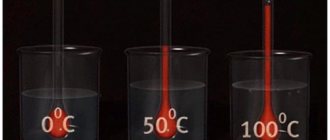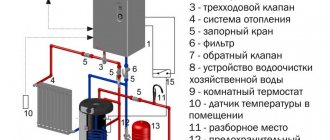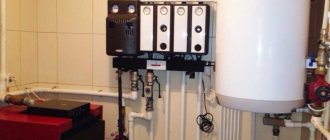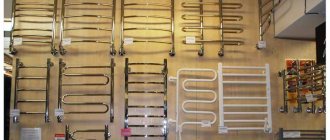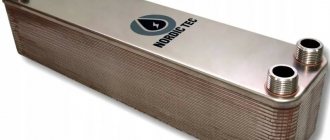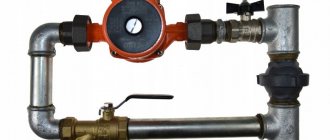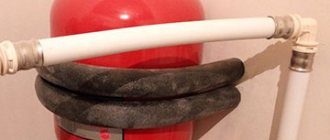The volume of water or coolant in various pipelines, such as low-pressure polyethylene (HDPE pipe), polypropylene pipes, fiberglass-reinforced pipes, metal-plastic pipes, steel pipes, must be known when selecting any equipment, in particular an expansion tank.
For example, in a metal-plastic pipe with a diameter of 16, a meter of pipe is 0.115 g. coolant.
Did you know? Most likely no. And why do you actually need to know this until you are faced with the selection of, for example, an expansion tank. Knowing the volume of coolant in the heating system is necessary not only for selecting an expansion tank, but also for purchasing antifreeze. Antifreeze is sold undiluted to -65 degrees and diluted to -30 degrees. Once you know the volume of coolant in the heating system, you can buy an even amount of antifreeze. For example, undiluted antifreeze must be diluted 50*50 (water*antifreeze), which means that with a coolant volume of 50 liters, you will need to buy only 25 liters of antifreeze.
We present to your attention a form for calculating the volume of water (coolant) in the pipeline and heating radiators. Enter the length of a pipe of a certain diameter and instantly find out how much coolant is in this section.
What is needed to expand the balcony
Since the entire structure must be very reliable, no used materials are used for its construction - all metal parts must be free of rust, not deformed and of good quality.
Also, all rolled metal should be treated with anti-corrosive to extend its service life. Materials for slab expansion:
- Metal corner 40x40 or 50x50 mm;
- Profiled pipe with a cross section of 100x50 mm;
- Band;
- Channel;
- Profiled sheeting.
Before purchasing the necessary materials, the balcony is measured and linear meters of metal parts are calculated. All calculations are performed individually, depending on the size of the balcony and how much it will increase.
Read more: Sample collective letter in defense of a manager
Since all metal parts are connected by welding, you will also need a welding machine and a welder. If you don’t know any welders, you can invite a hired worker who will complete all the welding work in 2-3 days.
Heat generator power
One of the main components of the heating system is the boiler: electric, gas, combined – it doesn’t matter at this stage. Because its main characteristic is important to us - power, that is, the amount of energy per unit of time that will be spent on heating.
The power of the boiler itself is determined by the formula below:
Wboiler = (Sroom*Wshare) / 10,
Where:
- Sroom – the sum of the areas of all rooms that require heating;
- Wdel – specific power taking into account the climatic conditions of the location (this is why it was necessary to know the climate of the region).
Typically, for different climatic zones we have the following data:
- northern regions – 1.5 – 2 kW/m2;
- central zone – 1 – 1.5 kW/m2;
- southern regions – 0.6 – 1 kW/m2.
These figures are quite arbitrary, but nevertheless provide a clear numerical answer regarding the influence of the environment on the apartment heating system.
Complete environmental cleanliness and hygiene of drinking water supply systems
Every self-respecting person, reputable company or organization constantly cares not only about themselves, but also about the health of their relatives and subordinates. And it all starts with water, just like our life in general. So, first of all, you need to think about supplying environmentally and hygienically pure juice of the Earth - this is also called water.
This problem was solved by German specialists who use environmentally friendly fusiolen PP-R raw materials for the production of aquatherm pipes.
Professionals from Germany for a comprehensive study of the material used not only their own laboratories available at the aquatherm GmbH plant, but also took advantage of equipment that was kindly provided to them by many independent laboratories.
The results of the experiments confirmed the high environmental standards of the factory raw materials used for the production of pipe structures.
Moreover, due to many positive physical and chemical properties, a number of special requirements for drinking water supply and heating were taken into account when creating the materials. “Material of the future” is the name given to fusiolen PP-R raw materials.
Compliance with GN 2.1.5.1315-03, availability of Greenpeace and LEED USA certificates indicates that the material does not contain metals harmful to health (copper, iron, nickel, lead, etc.), and also eliminates the possibility of emission of harmful substances during operation into the environment.
Antifreeze as a coolant
This type of coolant, such as antifreeze, has higher characteristics for efficient operation of the heating system. By pouring antifreeze into the heating system circuit, you can reduce the risk of the heating system freezing during the cold season to a minimum. Antifreeze is designed for lower temperatures than water, and they are not able to change its physical condition. Antifreeze has many advantages, since it does not cause scale deposits and does not contribute to corrosive wear of the internal area of the heating system elements.
Even if antifreeze hardens at very low temperatures, it will not expand like water, and this will not cause any damage to heating system components. If it freezes, the antifreeze will turn into a gel-like composition, and the volume will remain the same. If, after freezing, the temperature of the coolant in the heating system increases, it will go from a gel-like state to a liquid state, and this will not cause any negative consequences for the heating circuit.
Many manufacturers add various additives to antifreeze that can increase the service life of the heating system.
Such additives help remove various deposits and scale from heating system elements, and also eliminate pockets of corrosion. When choosing antifreeze, you need to remember that such a coolant is not universal. The additives it contains are only suitable for certain materials.
Existing coolants for heating systems-antifreeze can be divided into two categories based on their freezing point. Some are designed for temperatures down to -6 degrees, and others up to -35 degrees.
Properties of various types of antifreeze
The composition of a coolant such as antifreeze is designed for a full five years of operation, or 10 heating seasons. The calculation of the coolant in the heating system must be accurate.
Antifreeze also has its disadvantages:
- The heat capacity of antifreeze is 15% lower than that of water, which means they will release heat more slowly;
- They have a fairly high viscosity, which means that a fairly powerful circulation pump will need to be installed in the system.
- When heated, antifreeze increases in volume more than water, which means that the heating system must include a closed expansion tank, and radiators must have a larger capacity than those used to organize a heating system in which water is the coolant.
- The speed of the coolant in the heating system - that is, the fluidity of antifreeze is 50% greater than that of water, which means that all connecting connectors of the heating system must be very carefully sealed.
- Antifreeze, which includes ethylene glycol, is toxic to humans, so it can only be used for single-circuit boilers.
When using a type of coolant such as antifreeze in a heating system, certain conditions must be taken into account:
- The system must be supplemented with a circulation pump with powerful parameters. If the circulation of coolant in the heating system and the heating circuit is long, then the circulation pump must be installed externally.
- The volume of the expansion tank must be no less than twice that of the tank used for a coolant such as water.
- It is necessary to install volumetric radiators and pipes with a large diameter in the heating system.
- It is prohibited to use automatic type air vents. For a heating system in which antifreeze is the coolant, only manual taps can be used. A more popular manual type crane is the Mayevsky crane.
- If antifreeze is diluted, then only with distilled water. Melt, rain or well water will not work.
- Before filling the heating system with coolant - antifreeze, it must be thoroughly rinsed with water, not forgetting about the boiler. Manufacturers of antifreeze recommend changing them in the heating system at least once every three years.
- If the boiler is cold, it is not recommended to immediately set high coolant temperature standards for the heating system. It should rise gradually, the coolant needs some time to heat up.
If in winter a double-circuit boiler running on antifreeze is turned off for a long period, then it is necessary to drain the water from the hot water supply circuit. If water freezes, it can expand and cause damage to pipes or other heating system components.
Soldering of polypropylene pipes
For this, a special soldering iron is used, on which nozzles are installed that can heat pipes of different diameters. One side of the nozzle heats the pipe from the outside and from the end; it is shaped like a small glass, and the second heats the connecting element (tee, angle or coupling).
The task is to simultaneously melt the outer part of the pipe and the internal cavity of the transition. It is at this moment that many novice plumbers make one significant mistake - they must not overheat the pipe and connector. This is fraught with the fact that the small internal hole intended for the flow of water is, at best, almost halved, which reduces the throughput of the pipe, and at worst, it seals it tightly. And then look for where it happened, it’s good if you haven’t had time to wall it up yet.
We insert the pipe and the “connector” into the nozzles, forcefully press them into it until it stops, count two or three seconds, remove the pipe from the soldering iron and connect the two elements together. Here you need to understand that the larger the diameter of the pipes being connected, the more time it takes to warm them up. Let's just say that 2-3 seconds of warming up is an axiom for a pipe ø20 (in the old days it is ½ inch), and for the subsequent diameter (ø25 or ¾ inch) the warming up time increases to 5-6 seconds. And so on with each diameter.
READ ALSO: Why Frost is Dangerous for HDPE Pipes
Then another nuance arises. Firstly, the elements to be joined must be held with force until the polypropylene hardens - as a rule, this is 15-20 seconds. Secondly, at the moment the polypropylene hardens, you need to hold it firmly and securely so as not to turn or move the pipe in the connector. If you disturb the joint at this moment, you're guaranteed to leak.
Droplets of water that may remain in the plumbing system during its repair or the addition of any elements have the same detrimental effect on the joint. The steam generated at high temperatures simply will not allow the polypropylene to combine into a single whole. In this case, ordinary bread crumb is used. It is packed into the pipe and gives several additional tens of seconds, during which you need to have time to solder everything. Subsequently, the crumb is completely dissolved by water, and there can be no talk of any plugs.
If you are soldering polypropylene pipes for the first time, it would be good to invite a person who has already done similar work as an assistant. Experience is of great importance, and in some moments, competent advice on how to properly solder polypropylene pipes can be very helpful.
At first, when mastering this type of work, soldering propylene pipes will not be done quickly at all. But you shouldn’t rush, because if you rush, the quality will suffer. Do you need leaks?
By gaining experience, you will learn to work more efficiently, and the time spent on soldering polypropylene pipes will be reduced.
Who knows, over time, having learned how to solder propylene pipes, you may want to improve not only the plumbing in your home, but also the sewerage and heating systems, and you will be able to help your friends in repairing communications.
Calculation of the volume of the heating expansion tank
Design of the expansion tank
For safe operation of the heating system, it is necessary to install special equipment - an air vent, a drain valve and an expansion tank. The latter is designed to compensate for the thermal expansion of hot water and reduce the critical pressure to normal levels.
Closed tank
The actual volume of the expansion tank for the heating system is not constant. This is due to its design. For closed heat supply circuits, membrane models are installed, divided into two chambers. One of them is filled with air with a certain pressure indicator. It should be 10% -15% less than the critical value for the heating system. The second part is filled with water from a pipe connected to the main line.
To calculate the volume of the expansion tank in the heating system, you need to find out its filling coefficient (Kzap). This value can be taken from the table data:
Expansion tank fill factor table
In addition to this indicator, you will need to determine additional:
- The normalized coefficient of thermal expansion of water at a temperature of +85°C, E – 0.034;
- Total volume of water in the heating system, C;
- Initial (Pmin) and maximum (Pmax) pressure in the pipes.
Further calculations of the volume of the expansion tank for the heating system are performed using the formula:
If antifreeze or other non-freezing liquid is used in heat supply, the value of the expansion coefficient will be 10-15% higher. According to this method, it is possible to calculate with great accuracy the capacity of the expansion tank in the heating system.
Open expansion tank
Open expansion tank
To calculate the volume of an open expansion tank in a heating system, you can use a less labor-intensive method. Fewer requirements are placed on it, since in fact it is necessary to control the coolant level.
The main value is the thermal expansion of water as its degree of heating increases. This figure is 0.3% for every +10°C. Knowing the total volume of the heating system and the thermal operating conditions, you can calculate the maximum volume of the tank. It should be remembered that it can only be 2/3 filled with coolant. Let's assume that the capacity of the pipes and radiators is 450 liters, and the maximum temperature is +90°C. Then the recommended volume of the expansion tank is calculated using the following formula:
Vtank=450*(0.003*9)/2/3=18 liters.
It is recommended to increase the obtained result by 10-15%. This is due to possible changes in the overall calculation of the volume of water in the heating system when installing additional batteries and radiators.
Material properties
Polypropylene is a kind of thermoplastic polymer. It is made by combining (polymerizing) molecules of the derivative gas ethylene. International designation of polypropylene “PP”. Let's take a closer look at the properties and manufacturing technology of this new generation material.
Possessing unique resistance to alkaline solvents and aggressive substances, the material is widely used in the installation of any plumbing structures. Withstands low and high temperature conditions, they can vary from minus 10 to plus 100 C.
Method for calculating the volume of a membrane expansion tank for a heating system:
The calculation presented below is intended for individual heating systems and is significantly simplified. Its accuracy is 10%. We think this is quite enough
1. Let's determine what type of liquid you will use as a coolant. For an example of calculation, we will take water as a coolant. The coefficient of thermal expansion of water is assumed to be 0.034 (this corresponds to a temperature of 85oC)
2. Determine the volume of water in the system. It can be approximately calculated depending on the boiler power at the rate of 15 liters per kilowatt of power. For example, with a boiler power of 40 kW, the volume of water in the system will be equal to 600 liters
3. Determine the maximum permissible pressure in the heating system. It is set by the response threshold of the safety valve in the heating system
4. The calculations also use the value of the initial air pressure in the expansion tank Po. The Po pressure must not be less than the gyrostatic pressure of the heating system at the location of the expansion tank
5. The total expansion volume V can be calculated using the formula:
V = (ex C) / (1 - (Po/Pmax))
The most typical failures of internal combustion engine 21083
Overheat
Common causes of engine overheating are thermostat failure, fan wedge, and coolant leaks.
Triple
Unstable engine operation is usually caused by a malfunction of one of the components of the contactless ignition system. Start checking with spark plugs, high-voltage wires and the distributor cover.
The revolutions are floating
Engine speed at idle most often fluctuates due to the vagaries of the Solex carburetor. Perhaps one of the jets is clogged, or the forced idle economizer may be faulty.
Knocks in the engine
Since this engine is prone to detonation, it is important to set the ignition timing correctly and try to use high-quality fuel. Unadjusted valves can also make a lot of noise under the hood.
Project preparation
Before starting construction, it is necessary to prepare an appropriate project, in which the main parameters and features of the future building will be observed and indicated. The balcony is no exception and also needs design.
Let's consider the features and procedure for designing a balcony:
- First of all, before starting design, it will be necessary to collect some information regarding the functional features of the house itself. It is necessary to clarify whether additional buildings are allowed according to technical data, as well as the parameters that the building may have;
- Based on the data obtained, a rough design of the balcony room is made, which is necessary to present to lawyers in order to obtain a building permit. Next, the project is finalized, improved and presented in this form to the BTI;
- When designing, it is necessary to take into account absolutely everything: the stability of the structure, the weight of the materials to be used, as well as equipping the balcony with appropriate fastenings. In order for the design to be reliable, it is necessary to take into account all aspects and reflect them as accurately as possible in the drawings, according to which the construction will be carried out.
Internal and external cross-section of plastic pipelines
Table of internal and external diameters of pipes
A wide range of plastic pipes contributes to their increasing popularity as a material for the installation of various pipelines for both domestic and industrial purposes.
And now, where previously exclusively steel pipes were used, they are being replaced by plastic ones, which are not only cheaper, but often more durable than their steel counterparts. But their advantages are not limited to these indicators.
There are a number of other important advantages:
- hygiene and environmental safety of pipes - due to its smoothness, lime deposits and colonies of microorganisms do not form on the inner surface of plastic pipes, and the pipe material is safe for the human body,
- low heat and sound conductivity ensure low heat losses and quieter operation of pipelines,
- the low weight of plastic reduces the load on structures, facilitates the installation of pipes and their transportation,
- visual appeal and no need to paint pipelines,
- no corrosion that reduces the strength of the plastic.
Basically, at a given time, several types of plastic pipes are used.
These are pipes such as:
Each type of pipe has its own advantages and features of use, which must be taken into account when purchasing them, based on the purpose of the future pipeline.
What is the difference between the designations of metal and plastic pipes?
But it is equally important to know that the diameters and designations of metal and plastic pipes differ. If metal pipes are designated based on their internal diameter, then the outer diameter is always indicated in the marking of plastic pipes
If metal pipes are designated based on their internal diameter, then the outer diameter is always indicated in the marking of plastic pipes.
In addition, inches are used to designate the diameters of metal pipes, while for plastic pipes the metric system is used, indicating the pipe size in millimeters.
How can this be done? In order to correctly replace one pipe with another, it is necessary to focus not on the diameter of the pipe, but on the nominal diameter.
What is a “nominal pipe bore”? The nominal bore of both pipes and connecting parts means the average internal diameter of the pipe (in the clear), which is designated as DN with the addition of a digital designation equal to the nominal bore expressed in millimeters (for example, DN90).
Calculation of coolant consumption
Previously, each heating branch is divided into sections. The breakdown is made taking into account water consumption, which varies from one heating element to another. First, determine exactly what volume of coolant is needed for high performance of the heating device, using the formula: G = 860q/Δt, where:
- G—required volume of coolant (kg/h);
- q — thermal power of the heating element (kW);
- Δt is the temperature difference between the supply and return heating circuits. As a rule, +20C is used.
In this video you will learn what the hydraulic calculation system looks like:
The hydraulic calculation of heating begins with the final heating element, the one furthest from the boiler unit, since it is this element that must be provided with the required volume of heated water per section of the battery. If the section power is 2 kW, then calculations can be made using the following data: 860 x 2 ÷ 20 = 86 (kg/h).
It will be more convenient to convert the final value into liters using the formula: GV = G /3600ρ, where:
- GV is coolant consumption;
- ρ is the density of water, the value of which is given in the tables.
How to calculate cross-sectional area
If the pipe is round, the cross-sectional area should be calculated using the formula for the area of a circle: S = π*R2. Where R is the radius (internal), π is 3.14. In total, you need to square the radius and multiply it by 3.14. For example, the cross-sectional area of a pipe with a diameter of 90 mm. We find the radius - 90 mm / 2 = 45 mm. In centimeters this is 4.5 cm. We square it: 4.5 * 4.5 = 2.025 cm2, substitute it into the formula S = 2 * 20.25 cm2 = 40.5 cm2.
The cross-sectional area of a profiled product is calculated using the formula for the area of a rectangle: S = a * b, where a and b are the lengths of the sides of the rectangle. If we consider the cross-section of the profile to be 40 x 50 mm, we get S = 40 mm * 50 mm = 2000 mm2 or 20 cm2 or 0.002 m2.
Heating system volume
Calculating the volume of the heating system is necessary to determine the volume of the expansion tank, select a heating boiler or determine the required amount of coolant.
The procedure for calculating the volume of a heating system. Calculation of the volume of coolant in heating radiators. Calculation of the volume of coolant in heating pipes. Example of calculating the volume of a heating system.
Calculating the volume of a heating system is quite simple; to do this, you need to sum up the internal volume of all elements of the system. The problem arises precisely in determining the volume of internal elements; in order not to re-read GOST standards and passports for heating devices, this article contains all the necessary information. It will greatly simplify the calculation of your heating system.
Calculator for calculating the total volume of the heating system
However, in this case, you should also take into account the volume of the expansion tank and the internal volume of the boiler heat exchanger. All this information is present in the boiler passport.
Volume of water in a heating radiator - aluminum, cast iron, bimetallic
There are many reasons why you may need to know the volume of water in a heating radiator. The easiest way is to look at the specifications, instructions or other documentation for the product. But what to do if it is not there?
From this article you will learn how many liters of water are in one section of a heating radiator, depending on its model and dimensions. We will also tell you how to calculate this indicator for non-standard models.
How much water is in one section of a cast iron radiator?
Cast iron batteries differ in section height, depth, power and weight. For example, the MC 140-500 model has a height of 50 mm and a depth of 140 mm. Basically, the volume of water in the cast iron section of the radiator is affected by its height.
The most common is the MS series. Depending on the manufacturer, the volume of coolant may vary, so there is a slight scatter.
Volume of one section of the MS brand (in liters)
- MS 140-300 – 0.8-1.3;
- MS 140-500 – 1.3-1.8;
- MS-140 – 1.1-1.4;
- MS 90-500 – 0.9-1.2;
- MS 100-500 – 0.9-1.2;
- MS 110-500 – 1-1.4.
Dimensions of aluminum heating radiators, sections and pipes
Cast iron batteries of the ChM series are very popular. The model marking indicates the number of channels, height and depth of the section. For example, ChM2-100-300 has a height of 300 mm, a depth of 100 mm, and water circulates in it through two channels.
Volume of water in one section of the ChM brand (in liters)
- World Championship 1-70-300 – 0.66;
- World Championship1-70-500 – 0.9;
- World Championship2-100-300 – 0.7;
- World Championship2-100-500 – 0.95;
- ChM3-120-300 – 0.95;
- World Championship3-120-500 – 1.38.
The data below is consistent with other manufacturers' specifications. To play it safe, you can use them by adding a 20 percent safety margin.
Water volume in one section of an aluminum radiator
There are dozens of manufacturers of aluminum heating radiators, the products of each of them differ in the design and size of the internal channels. Therefore, we can only approximately say how much water is in one section of an aluminum radiator.
The main difference between the models is in height, so here is a list of the most common sizes (data are given in liters):
- 350 mm – 0.2-0.3;
- 500 mm – 0.35-0.45;
- 600 mm – 0.4-0.5;
- 900 mm – 0.6-0.8;
- 1200 mm – 0.8-1.
For non-standard sizes, you can use the formula (V – volume in liters, h – height in meters):
V = hx 0.8
The result will be approximate, but if you don’t have the equipment specifications at hand, you can use the obtained value. This way you can determine how much water is in one fin of an aluminum battery with an error of no more than 20%.
Please note that the capacity of an aluminum heating radiator may decrease over time due to corrosion. It is formed due to water with poor alkalinity or acidity. Also, the volume of liquid in an aluminum radiator may be reduced due to silting.
Which bimetallic radiator to choose - expert secrets
As with aluminum, there are many options for manufacturers and brands of bimetallic radiators. Their structure, appearance, and channel diameters differ in the same way.
The volume of water in a bimetallic radiator depends on its height and is (in liters):
- 35 cm – 0.1-0.15;
- 50 cm – 0.2-0.3;
- 60 cm – 0.25-0.35;
- 90 cm – 0.3-0.5;
- 120 cm – 0.4-0.6.
To calculate the volume of a section of a bimetallic radiator of non-standard height, use the formula (V – volume in liters, h – height in meters):
V = hx 0.35
This will give you an approximate value, which may vary within 20%.
Water volume in the heating radiator table
| Aluminum | 350 | 0,2 | 0,3 |
| 500 | 0,35 | 0,45 | |
| 600 | 0,4 | 0,5 | |
| 900 | 0,6 | 0,8 | |
| 1200 | 0,8 | 1 | |
| Bimetallic | 350 | 0,1 | 0,15 |
| 500 | 0,2 | 0,3 | |
| 600 | 0,25 | 0,35 | |
| 900 | 0,3 | 0,5 | |
| 1200 | 0,4 | 0,6 | |
| Cast iron | MS 140-300 | 0,8 | 1,3 |
| MS 140-500 | 1,3 | 1,8 | |
| MS-140 | 1,1 | 1,4 | |
| MS 90-500 | 0,9 | 1,2 | |
| MS 100-500 | 0,9 | 0,2 | |
| MS 110-500 | 1 | 1,4 |
We hope that we were able to help you determine the volume of water in one section of the battery. Let us remind you: if you are going to make any manipulations with the heating system, it is better not to take risks.
When working with non-standard models, calculate their volume with a small margin of 10-20%. This will not complicate the task, but will help avoid trouble. Don't forget to share the article with your friends!
(6 4.83 out of 5) Loading…
Technical characteristics of pipes and table of diameters
The choice of products depends on the following technical indicators:
- Diameter of polypropylene pipes for water supply in an apartment or house. There are products on sale with a diameter of 15-1200 mm, which are suitable for creating structures at home and in production.
- Marking. The letters PN indicate that the pipes are suitable for water supply at any temperature and can withstand a certain pressure.
- Diameter of pipes from the inside. The thicker the wall, the more pressure it can withstand.
- Length. The parameter does not affect the quality, but it will help to distinguish “self-made” from factory products: all factory elements are produced in a length of 6 m.
The presented table of diameters of reinforced and non-reinforced polypropylene pipes will help you select elements for arranging systems. We are considering a polypropylene pipe without reinforcement and with foil reinforcement:
| Diameter (mm) | Quantity per package (pcs.) |
| 20 | 100 |
| 25 | 80 |
| 32 | 40 |
| 40 | 32 |
| 50 | 20 |
| 63 | 16 |
| 75 | 12 |
| 90 | 8 |
| 110 | 4 |
How to calculate the volume of water in a heating system
Water consumption in centralized heating systems is not taken into account by ordinary users. But it is necessary to know the volume of the heating system that is created to equip a separate apartment (house). This data will help more accurately determine several important operational parameters, which will be discussed below.
Why do you need to calculate the amount of water in the heating system?
When installing the appropriate equipment in private country houses, many owners prefer to use special liquids.
High-quality antifreeze, with special additives, prevents the occurrence of corrosion processes, which increases the durability of metal pipes and other components of the engineering system. It does not turn into ice at low temperatures.
This property is useful in case of unauthorized shutdown of equipment or in other emergency situations. But such liquid is more expensive than water, so an accurate calculation of needs is necessary.
The second task is to clarify the volume of the expansion tank capacity. If it is insufficient in closed systems, then the device will not fully perform its functions of compensating for the expansion of the liquid when heated.
How to determine the amount of water experimentally, make a calculation
The easiest way to find out how much fluid is needed to fill the system is experience. After connecting new heating equipment to the house, the valve opens to fill them. The required value will be obtained as a result of the water consumption meter readings. The second option is the opposite action. You can drain the system using a bucket or other container with a known volume.
It is clear that such operations are permissible only if there is equipment installed at home. In reality, you will have to do the calculations in advance in order to correctly determine the parameters of the corresponding project. Next, we will consider the correct sequence of actions that will help calculate the volume of coolant:
- The amount of liquid that the boiler can hold is determined. These data are indicated in the technical data sheet for the corresponding product. Flow-type devices are more economical. But those that use storage tanks can quickly provide consumers with hot water. In some models of solid fuel boilers, the corresponding volume reaches 50 liters.
- The following summarizes the similar characteristics of heating radiators. As a rule, the largest ones are cast iron radiators. Filling one section of such a device may require at least one and a half liters of liquid.
- The piping capacity is calculated only taking into account the data on the pipes. To make the calculation, the following formula is used: V (volume of liquid to fill the pipeline) = P (3, 14 - number “Pi”) x R 2 (pipe radius to the second power) x L (pipeline length).
- The last action is the summation of the available values.
https://youtube.com/watch?v=GrYdSoMrDqc
To correctly calculate the internal volume of pipes, you must use only comparable values. The exact radius is calculated by subtracting twice the width of the walls. Let's give an example based on the following initial data:
- Pipe length: 12 meters.
- Diameter (outer): 24 mm.
- Wall thickness: 2 mm.
First you need to calculate the internal radius: R = 24 - (2x2)/2 = 10 mm.
Now you can use the above formula: V = 3.14 x 10 2 /1000 x 12 = 3.768 liters. The volumes of the boiler and heating radiators are added to this value.
What should be the size of the expansion tank capacity?
As a rule, it is necessary to accurately calculate this value if it is planned to create a closed-type heating system at home. To obtain the desired value, use the following formula: VR (volume of the expansion tank) = (VO (total volume, which is calculated using the method discussed above) x KR (liquid expansion coefficient)) / KE (efficiency coefficient). KR is assumed to be 0.04 for water (antifreeze - 0.044). KE is an indicator that is calculated using the formula: KE = (PM (maximum system pressure) – PN (nominal pressure at which the tank is filled))/ (PM+1).
https://youtube.com/watch?v=syF9KpsxZO8
Thus, in order to find out the amount of non-freezing liquid to fill the heating system, you need to add up all the volumes listed above:
- boiler;
- batteries;
- pipeline;
- expansion tank.
An example of calculating the volume of a heating system
The heating pipes are steel, the risers are made of 1/2'' pipes, the supply and return are made of 1'' pipes. The total length of the risers is 12 m, the return and supply length is 20 m.
We count. 12x0.177+20x0.491=11.944 l.
Now it remains to add up the volume of coolant in the radiators, in the heating pipes, in the boiler (the volume is indicated in the passport), the expansion tank and, as a result, the volume of the heating system.
Thus, the volume of the heating system is the sum of the volumes of all its elements. Knowing the volume of the heating system, you can begin to select an expansion tank or boiler. In addition, calculating the volume of the heating system is necessary when purchasing and filling the coolant. However, in this case, you should also take into account the volume of the expansion tank and the internal volume of the boiler heat exchanger. All this information is present in the boiler passport.
Why is bandwidth determined?
When calculating a water supply system, the task is to determine the optimal pipe diameter to ensure standard water consumption.
If the cross-section is too small, this leads to insufficient pressure in the pipes even at high pressure, resulting in:
- pumping equipment wears out faster,
- accidents occur more often on the line,
- energy consumption increases.
Repairing systems requires additional expenses, which increases the cost of operation.
In hydraulics, the throughput of the entire system is calculated based on the narrowest point. Pipelines are often compared to electrical wiring, only water flows through the pipes, and electric current flows through the wires.
Specific calculations
Let's say you need to make a calculation for a household with an area of 150 square meters. m. If we assume that 100 watts of heat are lost per 1 square meter, we get: 150x100 = 15 kW of heat loss.
How does this value relate to the circulation pump? With heat losses, there is a constant consumption of thermal energy. To maintain the temperature in the room, more energy is required than to compensate for it.
To calculate a circulation pump for a heating system, you should understand what its functions are. This device performs the following tasks:
- create a water pressure sufficient to overcome the hydraulic resistance of the system components;
- pump through pipes and radiators the volume of hot water required to effectively warm up the household.
That is, in order for the system to work, you need to adjust the thermal energy to the radiator. And this function is performed by the circulation pump. It is this that stimulates the supply of coolant to heating devices.
The next task: how much water, heated to the required temperature, must be delivered to the radiators over a certain period of time, while compensating for all heat loss? The answer is expressed in the amount of coolant pumped per unit time. This will be called the power that the circulation pump has. And vice versa: you can determine the approximate coolant flow rate based on the pump power.
Data needed for this:
- The amount of thermal energy required to compensate for heat loss. For this household with an area of 150 sq. meters this figure is 15 kW.
- The specific heat capacity of water, which acts as a coolant, is 4200 J per 1 kilogram of water, for every degree of temperature.
- Temperature delta between the water supply from the boiler and the last section of the return pipeline.
It is believed that under normal conditions this last value does not exceed 20 degrees. On average they take 15 degrees.
The formula for calculating the pump is as follows: G/(cx(T1-T2))= Q
- Q is the coolant consumption in the heating system. So much liquid at a certain temperature must be delivered to the circulation pump to the heating devices per unit of time in order for heat loss to be compensated. It is not advisable to purchase a device that has more power. This will only lead to increased electricity consumption.
- G - heat loss at home;
- T2 is the temperature of the coolant flowing from the boiler heat exchanger. This is exactly the temperature level that is needed to heat the room (about 80 degrees);
- T1 - temperature of the coolant in the return pipeline at the entrance to the boiler (most often 60 degrees);
- c is the specific heat capacity of water (4200 Joules per kg).
When calculated using the above formula, the figure is 2.4 kg/s.
Now we need to translate this indicator into the language of circulation pump manufacturers.
1 kilogram of water corresponds to 1 cubic decimeter. One cubic meter is equal to 1000 cubic decimeters.
It turns out that the pump pumps the following volume of water per second:
2.4/1000=0.0024 cubic meters m.
Next you need to convert seconds to hours:
0.0024x3600=8.64 cubic meters m/h.
